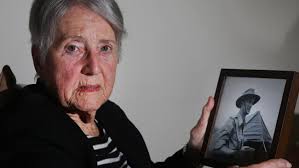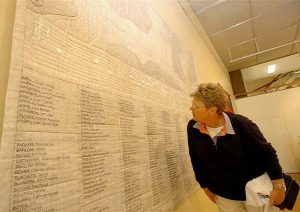Now on display at The United Nations Memorial Cemetery in Korea.
This article is provided by Leslie O’Brien, a Member, Korean War Honour Roll Quilt management committee and Anthea Green, daughter of Lieutenant Colonel Charles Green DSO, on behalf of Mrs. Olwyn Green OAM.

Mrs. Green is the widow of Lieutenant Colonel Charles Hercules Green DSO,Silver Star (United States) Commanding Officer 3 RAR, who died of wounds during the 1950-1953 Korean War.
Mrs. Green commissioned the Quilt to honour all Australian servicemen who lost their lives defending the freedom of the Republic of Korea during that conflict. In her own words, she intended the Korean War Honour Roll quilt to “tell a story, and to honour those who made the supreme sacrifice, especially in a critical time in the Korean War.”
The Quilt was designed by Australian textile artist Meredith Rowe. Its hand-dyed fabric and thread was inspired by Korean Buddhism. It was hand-stitched – over a period of at least 200 hours – by the ‘Sit and Sew’ group in rural Coleraine, Victoria.
There is a legal framework surrounding the Korean War Honour Roll Quilt, protecting its ownership and its designer’s Intellectual Property. The quilters have asked only that their role in its creation and development be acknowledged

Korean War Honour Roll Quilt
As the above image shows, the Quilt has three sections: an upper part that features the topography of Gapyeong (Kapyong), site of one of the most important battles for Australian soldiers during the Korean War. Its middle portion contains some of the notes of the Last Post. Its lower part records the names of the 340 Australian men who died during the Korean War.
Dr Alexander Norman, grandson of Lt. Col Green and Mrs. Green says:
“The Quilt has always struck me as a symbol of sacrifice, both in the obvious sense that it details the names of the dead but also because of the less obvious sacrifice of time given by the quilt designer and the quilters. The metaphor of the thread is itself a particularly poignant one, given the socio-political ties between Australia and Korea that have developed over the past sixty years. The thread ties memory to practice, and in particular it ties the sacrifices of those dead and alive to the place and to the people it creates and who create it. This is what makes the topographic dimension of the Quilt so important; it is not only about remembering people who have been lost but also about remembering places that continue.”
The Quilt was launched in Grafton NSW on 27 July 2003, timed to coincide with the 50th anniversary of the Korean War Armistice. Since then, this beautiful object has been displayed at a number of locations in Australia: the Australian War Memorial, the Shrine of Remembrance in Victoria, and the Army Infantry Museum, Lone Pine Barracks, Singleton.
The Quilt has now travelled to the Republic of Korea. Its first exhibition in that country, at the United Nations Memorial Cemetery Korea in Busan, opened on 25 October 2016. The cemetery, where rest the dead of the 16 countries that made up the UN force in the Korean War, is an appropriate place for the Korean War Honour Roll Quilt that acknowledges the Australian contingent who lost their lives. Here the quilt will speak to the world in a memorable, artistic way of service and sacrifice.
Mrs. Green would like to acknowledge and thank certain Koreans and Australians instrumental in the Quilt’s move to the Republic of Korea, especially those of the Embassy of Korea in Australia, the Embassy of Australia in Seoul, the UNMCK at Busan, and those who created the wonderful display case for the Quilt. Mrs. Green would like in particular to thank Koreans (in Korea and in Australia) for expressing their gratitude for Australia’s war support, by on-going commemorative events, not only in Australia but in Korea too. Korea’s ultimate gesture is to open its arms to the Korean War Honour Roll Quilt.
It would be helpful if this important account of the Quilt’s journey to its current resting place in Korea could be passed on to other interested organisations and individuals.
We are currently in the process of writing a detailed history of the Korean War Honour Roll Quilt. We intend to submit this material to relevant publications for consideration. In the meantime should you have any questions about the Quilt please feel free to contact me [email protected] and/or Anthea Green at [email protected] .
Speak Your Mind